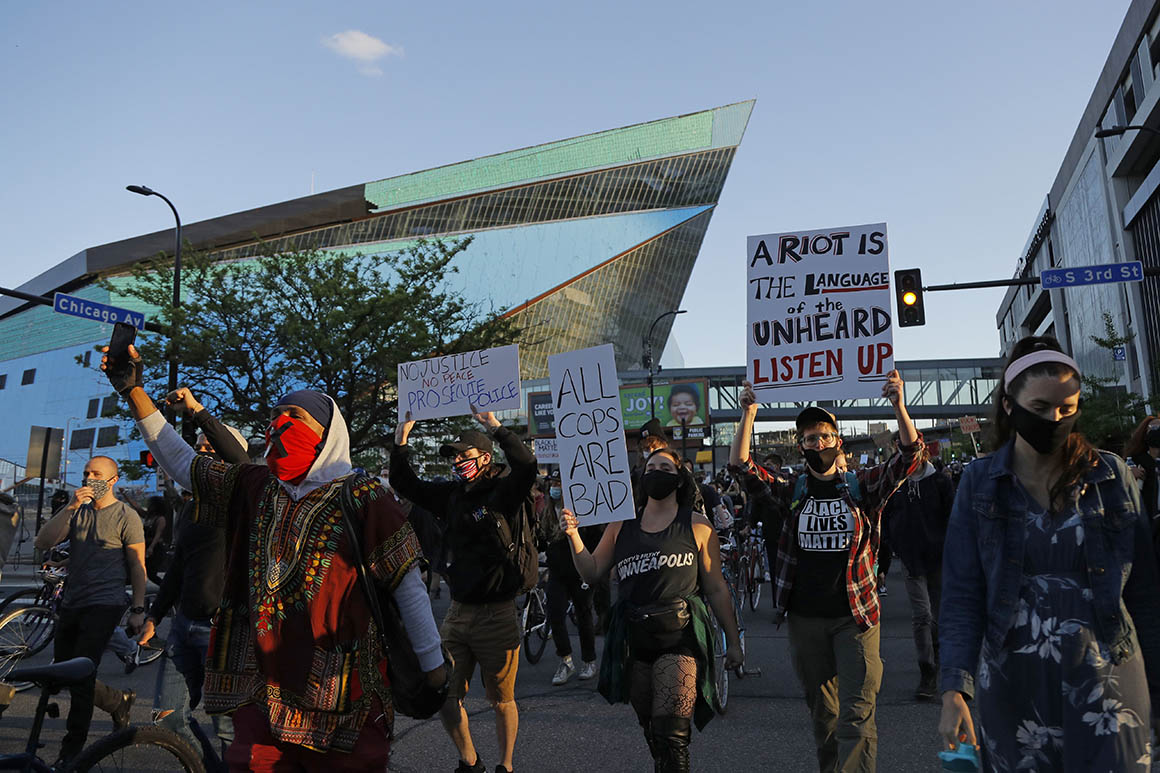
Outside the state, the president’s caustic remarks about protesters and the mayor of Minneapolis quickly underscored the political dimensions of the unrest, and the likelihood that it would become the next cultural wedge issue — another point of contention in the urban-rural divide that stands to define the November election.
For some Republicans, it was an opportunity to light into Democratic-led cities and appeal to their own law-and-order supporters. To many Democrats, it was the latest evidence of the structural racism that infects the system and must be confronted with aggressive political action — beginning with the ouster of a president whose rhetoric has frequently inflamed tensions.
Mike Erlandson, a former chairman of the Minnesota Democratic-Farmer Labor Party, said he watched with his 15-year-old daughter in Minnesota this week as a man spray-painted on a wall, “F–k the white people from the suburbs.”
“I do think that, particularly if this continues, the [congressional] districts like Dean Phillips’ district or Angie Craig’s district that right now I would say are relatively safe for the Democratic incumbent, could be very much in play,” he said. “Both of those districts will be decided in large part by suburban women voters, and it would be hard for me to imagine those people aren’t watching this scared, like everybody else, for their family and for their children.”
The president, who has repeatedly insisted he’ll win Minnesota in 2020, quickly seized on the chaos to revisit his criticisms of big-city Democratic leadership.
“I can’t stand back & watch this happen to a great American City, Minneapolis. A total lack of leadership. Either the very weak Radical Left Mayor, Jacob Frey, get his act together and bring the City under control, or I will send in the National Guard & get the job done right,” Trump tweeted Friday.
Trump’s reference to a “radical left mayor” was particularly resonant in Minnesota, whose political fault lines are felt deepest between the liberal Twin Cities and a sea of red in much of the surrounding farmland and on the Iron Range.
In 2016, Trump won 78 of the state’s 87 counties. Hillary Clinton’s narrow, 45,000-vote victory was powered by the population-rich Minneapolis-St. Paul area.
Javier Morillo, a Democratic strategist and former president of the Service Employees International Union Local 26, let out a groan Friday in response to Trump’s remarks.
“It’s lawless cities versus the real America – that’s the story they want to tell, anyway,” he said. “So that’s the dangerous territory … That’s the story they tell every election cycle in Minnesota, and frankly, that’s the story that almost won Minnesota for Trump four years ago, by building up turnout in the rest of the state, and our urban turnout being depressed.”
He said, “That’s the political danger.”
Minnesota is not critical to Trump’s reelection prospects. But it is one of the few offensive opportunities he has to win a state he lost in 2016, and he has invested heavily there.
Though a Star Tribune/MPR News/KARE 11 poll last weekend showed Trump lagging behind Biden by 5 percentage points, he had improved his standing significantly from October, when he was down 12 percentage points, and he is beating Biden in Minnesota’s rural areas and with men.
Even a marginal shift in the electorate in Minnesota could prove significant, not only in the presidential race, but in several House contests there. There are Phillips and Craig, two first-term Democratic representatives from suburban districts. But in rural, western Minnesota, House Agriculture Chairman Collin Peterson, a Democrat, is attempting to hang onto a seat that has become increasingly conservative in recent years — every county in his district voted for Trump, many by landslide margins.
This week, Republicans in Minnesota pounced on Tim Walz, the Democratic governor, and Frey, the Minneapolis mayor. Days of protests saw boarded-up storefronts and the closure of public transportation systems in the area. On Thursday, protesters set fire to the 3rd Precinct Minneapolis police station.
Jennifer Carnahan, chairwoman of the Minnesota Republican Party, said on Twitter that Walz and Frey had “failed us all.”
“I think the Democrats are going to pay dearly for this,” said Ted Lovdahl, chairman of the Republican Party in Minnesota’s 8th Congressional District.
While Trump claimed his tweets had been misinterpreted, Biden said Friday that he was “furious” with Trump. Democrats moved to balance calls for order while aligning themselves with people of color, a significant part of the Democratic Party’s base. The video of an officer kneeling on Floyd’s neck had painful historic and political resonance, conjuring past episodes of police violence against African-Americans as well as the culture wars of a previous election cycle surrounding Colin Kaepernick’s taking a past knee during the national anthem.
“This is serious,” a local pastor said at a rally Friday, addressing people who he said were upset about Kaepernick but not by the “knee on that man’s neck.”
Democrats had expected Floyd’s death and concerns about racism and police use of force to dominate the Minnesota Democratic-Farmer-Labor Party’s state convention over the weekend, a virtual event that Biden was scheduled to keynote.
But by Friday, with the weight of Floyd’s death and unrest in Minnesota growing heavier, the state party announced that it was postponing the speaking and training portion of the convention.
Ken Martin, the party chairman, said in a prepared statement that it “was the only appropriate course of action given the grief and anger gripping much of our state and nation.” Instead of convening, he said, the party will “support the efforts of black-led organizations and community organizations on the ground that are doing the work of addressing racial injustice.”
Source: politico.com
See more here: news365.stream






